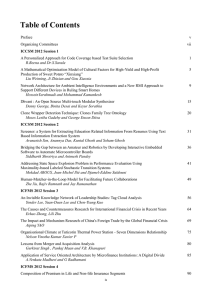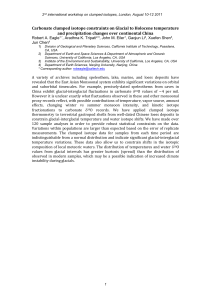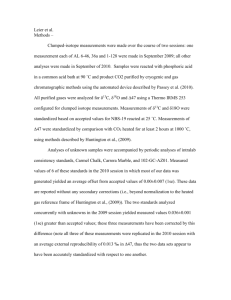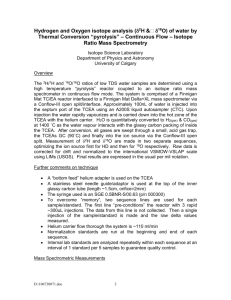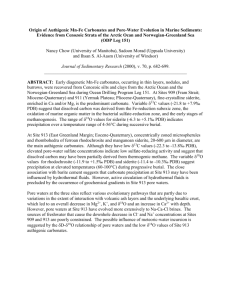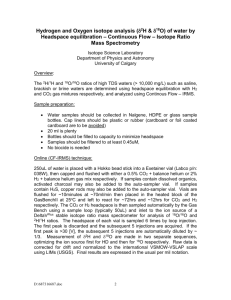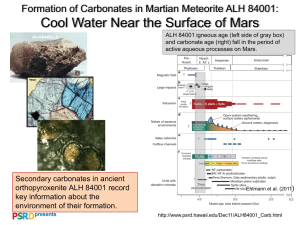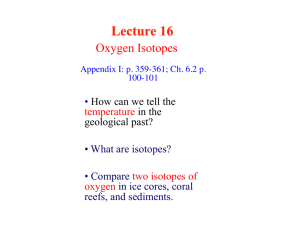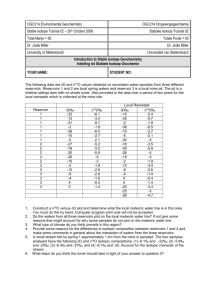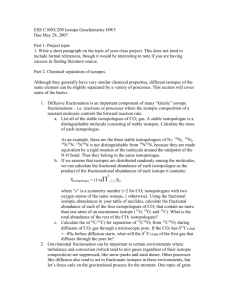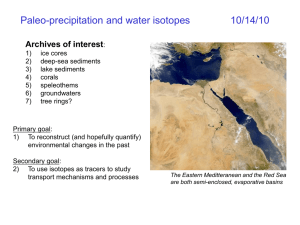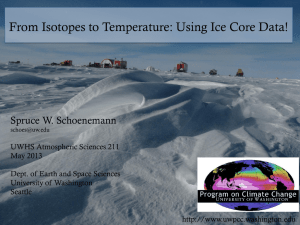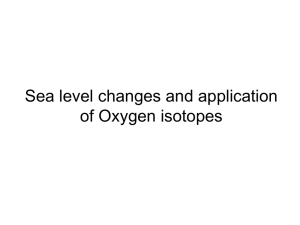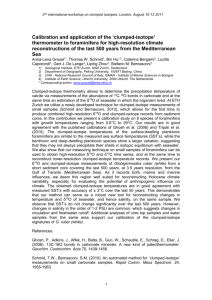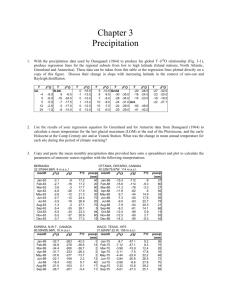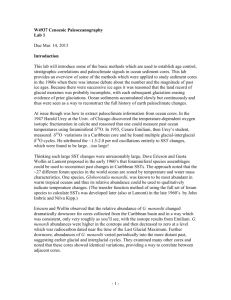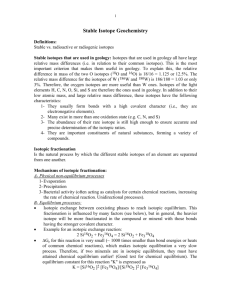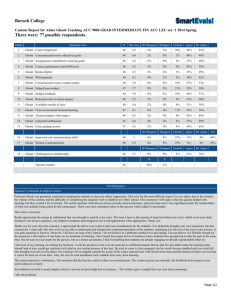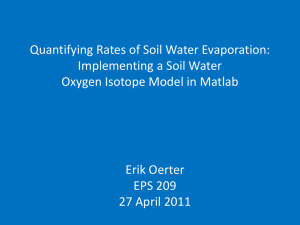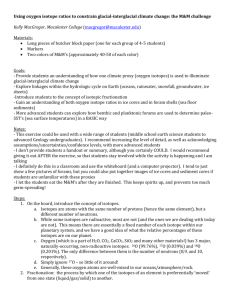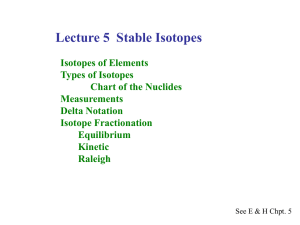“Clumped” isotopes: potential and challenges
advertisement
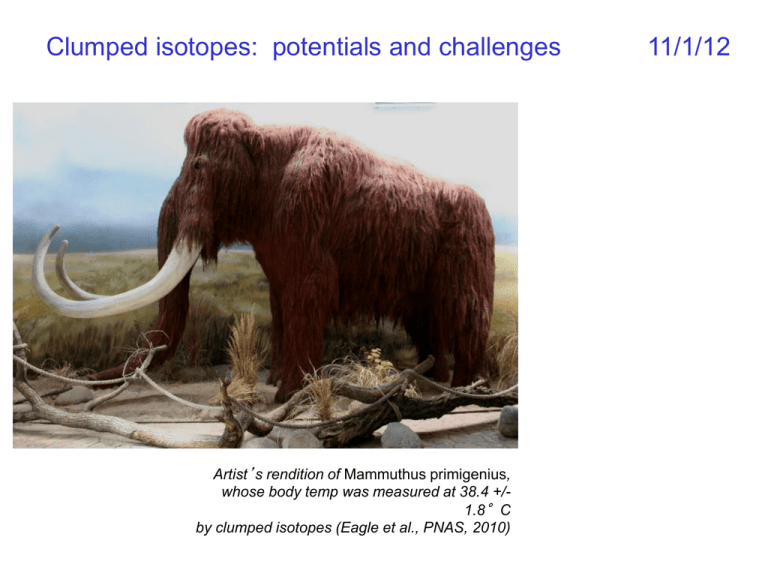
Clumped isotopes: potentials and challenges Artist’s rendition of Mammuthus primigenius, whose body temp was measured at 38.4 +/1.8°C by clumped isotopes (Eagle et al., PNAS, 2010) 11/1/12 The Idea Consider the isotope exchange rxn: we would expect an equilibrium constant of 0.25, given random distribution of isotopes BUT… there is a slight preference for D2, b/c of heavy isotope “clumping” AND… this preference is greater at low temperatures and less at high temperatures THEREFORE, we have established the basis for a paleo-thermometer that is based on the ordering of heavy isotopes in carbonate only (single phase equilbrium) NO dependence on fluid composition Eiler, 2007 Relevant Reaction and Isotopologues Elements Ghosh et al, 2006 CO32- Definition of Δ47 (where 47=16+18+13) Eiler and Schauble, 2004 How do you establish a new paleo-thermometer? 1) develop a way to reliably and repeatably measure the quantity of interest - choose to dissolve carbonate in H3PO4, measure evolved CO2 Ghosh et al, 2006 nominal precision = +/- 0.03‰ reducible to +/- 0.01-0.02‰ for repeat measurements 2) test the temperature sensitivity of Δ47 in inorganic and biogenic carbonates - observe a fractionation of of Δ47 from statistical model. Assuming it’s also T-dependent, must control for it when doing measurement Ghosh et al, 2006 2) test the temperature sensitivity of Δ47 in inorganic and biogenic carbonates - aragonite samples fall on calcite curve - some “vital” effects, as observed for these samples δ18O and δ13C Ghosh et al, 2006 3) go after real signals in real geologic records - eg: Red Sea coral Ghosh et al, 2006 3) go after real signals in real geologic records - sense of Δ47 signal matches that of Sr/Ca-based temperatures, but amplitude far exceeds that predicted from observed SST variations and calibrations of Δ47 (cause unknown “vital effect”?) expected Δ47 signal Ghosh et al, 2006 2) test the temperature sensitivity of Δ47 in inorganic and biogenic carbonates WOW: this really seems to work! Tripati et al, 2010 Vital effects and Δ47 Tripati et al, 2010 δ18O and δ13C of forams contain obvious “vital effects” Tripati et al, 2010 Data look pretty good, especially considering how the temperature is unknown for some forams’ habitats planktonic thermocline benthic Tripati et al, 2010 Δ47 of forams does not contain obvious “vital effects” Tripati et al, 2010 47 in Soreq cave speleothems Modern speleothem: 47=0.642±0.006‰, 26±1ºC. Modern bedrock temperature: 18 ºC. Kinetic isotope effect? 47 (‰) 18O from Matthews et al., 2000 18O reflects equilibrium within the range of observed cave water. Assumption: kinetic effect must be small. Affek et al, 2008 Combining kinetic and equilibrium effects - if you know the fluid composition, and you know the temperature, then you can predict a certain relationship between Δ47 and δ18O drip water 18O = -5.32±0.76‰ Affek et al, 2008 Combining kinetic and equilibrium effects drip water 18O = -5.32±0.76‰ Affek et al, 2008 • Both 18O and 47 are consistent with KIE offset at ~19°C. • The offset in 18O is lost in the natural variability of cave water 18O. Million dollar question: Is the offset constant through time? Affek et al, 2008 Temperature (°C) Yes? Clumped isotope T estimates agree with paleo-T estimates from other techniques Affek et al, 2008 Question: How fast did the Bolivian Altiplano uplift? Approach: Measure Δ47 and δ18Owater in carbonate nodules in paleosol Answer: it uplifted FAST! Ghosh et al, 2008 Implications of fast uplift: - removal of dense lower crust and/or mantle lithosphere, replacement by less dense, hot aesthenosphere caused isostatic rise in Altiplano? Ghosh et al, 2008 Question: How fast did the Colorado Plateau uplift? Approach: Measure Δ47 and δ18Owater in modern and ancient carbonates along an elevation gradient modern = calibration ancient = reconstruction Modern carbonates show that δ18Owater is not a good proxy for elevation, but Δ47 is Huntington et al, 2010 -little change in lapse rate inferred, so no change in elevation post-20Ma -large 8°C temperature change inferred (consistent with paleo-T from sediments off California?) Huntington et al, 2010 Modern Δ47 calibration of teeth bio-apatite Lesson: use enamel! So you can see the difference in old teeth from warm- and cold-blooded animals… Eagle et al, 2010 Large dinosaurs: warm- or cold-blooded? Eagle et al, 2011
